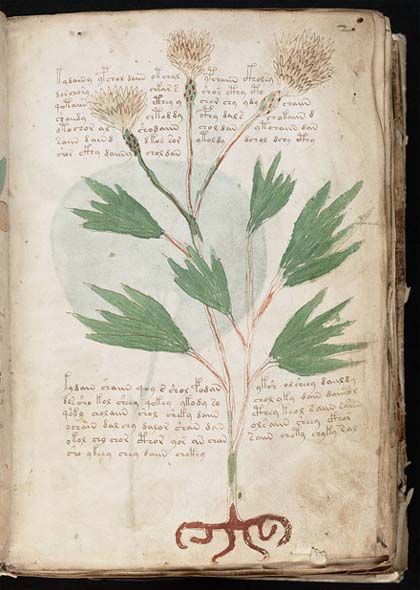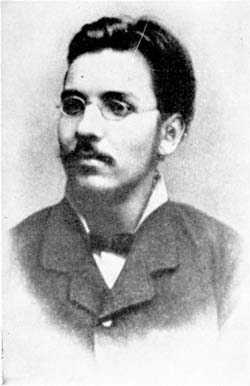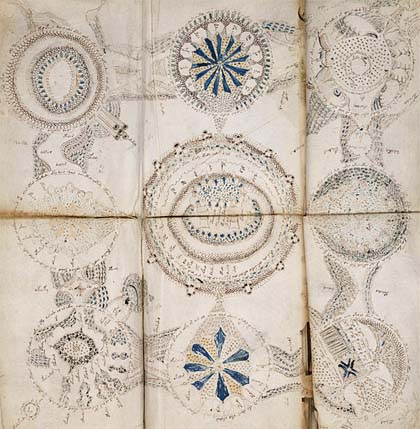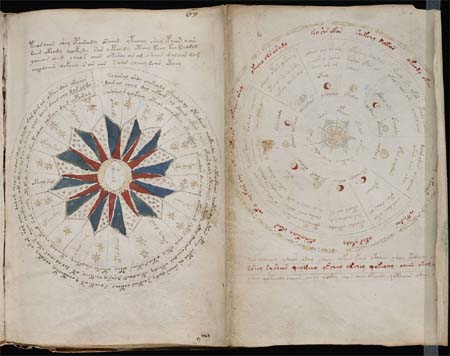The Mystery
of the Voynich Manuscript
|

A
page from the Voynich manuscript showing the strange writing
along with a color illustration.
|
In 1912
Wilfred M. Voynich was going through the archives of the Nobile
Collegio located at Villa Mondragone looking for some old, potentially
rare books. In a dusty chest he found a codex that wasn't just
rare, but also a puzzling enigma that has had researchers scratching
their heads for most of the last century.
The
Voynich manuscript is an illustrated, hand-written book around
240 pages in length (depending on how you count the book's foldout
sheets). It measures about 9 ½ inches tall, 6 ½ inches wide
and 2 inches thick. Its leaves, which have been carbon-dated
to the early 15th century (1404-1438), are made of vellum (calf
skin) and are covered not only with script, but also vivid,
color illustrations containing herbal, astronomical, biological,
cosmological, and pharmaceutical information. One of the features
of the book is that it has fold out pages that allow for extended
diagrams. All this, in of itself, would not make the manuscript
particularly unusual. In many ways it resembles other pharmacopoeias
(books containing instructions on making medicine) from the
medieval period. What makes it a mystery is that almost all
the text in the book is written in a language and script that
is totally unknown to the modern world.
Now
this doesn't mean it is written in a language like Rongo
Rongo where the meaning of this once well used prose has
simply been lost. For example, with Rongo Rongo we don't know
how to read it, but we do know it was used on Easter Island
until the 1860s and represents the spoken language Rapa Nui
which was used on the island.
No,
the script in the Voynich manuscript is written in a language
we know absolutely nothing about. No other letter or book that
we are aware of is written in this language. And it's not just
the language that is unknown, the letters themselves do not
seem to correspond to any known script. Most European languages
at least use most of the Latin alphabet, but the Voynich manuscript
does not. Neither does it seem to use any of the Arabic or Cyrillic
or Hebrew letters.
There
are also alot of other things we don't understand about the
Voynich manuscript. We don't know who wrote it. We can't identify
with any assurance any of the plants pictured in it and we don't
know anything about its origins. And although there are a handful
of notes on pages that appear to be written in Latin script,
we have no idea of what those mean, either.
History
|

Polish
book dealer Wilfred M. Voynich.
|
What
we do know is that there is a letter from 1666 that was found
inside the cover that states that the manuscript had once belonged
to the Holy Roman Emperor Rudolf II (1552-1612) and that he
paid 600 gold ducats to buy it. After Rudolf, the book seems
to have then been passed around until it ended up in the hands
of Georg Baresch, an alchemist living in Prague during the 15th
century. In 1639 Baresch wrote a letter to Athanasius Kircher,
a Jesuit scholar from the Collegio Romano, concerning the document.
Baresch's letter, the earliest known reference to the book,
tells us at least one important thing: That Baresch was just
as puzzled by the manuscript's writing as researchers are today.
Kircher was a language expert who had published a Coptic (Egyptian)
dictionary and was trying to decipher Egyptian hieroglyphs.
Baresch was trying to engage his assistance in translating the
manuscript and sent him several samples of the text.
While
Baresch was alive he refused to send Kircher the book itself,
but after his death Kircher acquired the codex from Jan Marek
Marci, a friend of Baresch. It is unknown if Kircher made any
progress on the translation, but the book wound up with much
of the rest of his library in the hands of the Collegio Romano
in Italy where Voynich found and purchased it in 1912. After
Voynich's death, his widow inherited the book. Eventually, antique
book dealer, Hans P. Kraus bought it and donated it to Yale
University, which still owns it today.
There
has been some speculation through the years that the author
of the book was the English philosopher, Franciscan friar and
writer Roger Bacon (1214-94). Marci mentions this possibility
in his 1666 letter to Kircher, and Voynich believed it too,
but no proof of a connection to the famous writer has ever been
found.
The
Illustrations
Since
the language is unknown, the illustrations are the only way
to tell what each section of the book is about. These too, however,
are extremely mysterious. None of the plants shown in the pictures
can absolutely be identified. Some astrological symbols can
be discerned, but not all of them. Other illustrations, containing
figures of naked women in tubs connected by an elaborate system
of pipes, seem to have no meaning at all. It does seem likely
that the illustrations were originally outlined in black ink
and the colors added at a later time by a less talented artist.
Is
It Encyphered?
Many
attempts have been made to understand the language in which
the book is inscribed. One theory is that the writing is some
secret code or cypher. The text of the book could have been
written in a standard European language, let's say Italian,
then translated into the cyphered text by assigning each letter
of the Latin alphabet to one letter in a new made up alphabet.
Without a key to tell you which letter was mapped to which,
reading the text would be extremely difficult.
|

One
of the foldout pages in the manuscript.
|
The
science of cryptography was becoming systemized in Europe at
about the same time the manuscript was written, so it seems
possible that the author may have decided to keep his book secret
by encrypting it. However, there are also some problems with
this theory.
A simple
substitution cypher, as described above, would also be very
easy to break with modern methods. These have been applied to
the Voynich manuscript and yielded nothing. In fact, attempts
to decrypt the codex assuming it used a number of more complex
encryption methods have failed, too. Even without being able
to decrypt the book, many cipher systems can be eliminated because
such ciphers produce text with certain characteristics not seen
in the manuscript.
A
Natural Language
Another
possibility is that the text was written in a little known-language
for which a new phonic alphabet was created. Analysis of the
frequency that the letters and groups of letters appear suggest
that the document is indeed a natural language. In 1976, James
R Child of the National Security Agency suggested that the document
was written in a "hitherto unknown North Germanic dialect".
In 2003, Zbigniew Banasik proposed that the manuscript is written
in the Manchu language. Other experts have suggested that the
manuscript may be in an unknown Chinese or Vietnamese dialect
because it has similar characteristics, including the frequency
of doubled and tripled words.
However,
none of these ideas have been proven, and the source and meaning
of the script remains unknown.
There
is the possibility that the language used in the Voynich manuscript
is an artificially-constructed language (that is one in which
the grammar and vocabulary have been consciously devised rather
than having arisen naturally). However, at the time of the writing
of the manuscript, the idea of a constructed language was not
yet well known, which makes this possibility seem unlikely.
Is
It a Fraud?
The
book is so odd that many people think that it is some kind of
hoax. Who might be behind such a forgery? Well, Voynich is one
of the first possibilities most people consider. As an antique
book dealer, he would have the knowledge and means to fabricate
such a document. If he could have convinced people that the
author was Roger Bacon, the value of the manuscript would have
been immense. Even though the pages have been carbon dated to
the 13th century, it is possible that Voynich found blank leaves
created in that period but never used. The iron gall ink used
in the writing can't be dated and could have been applied at
any time, so the possibility of a modern hoax can't be ruled
out completely.
However,
the likelihood of finding that number of unused vellum sheets
all from the same era seems to make a modern hoax very unlikely.
Also, the 1639 letter from Baresch to Kircher concerning the
manuscript proves that such a document did certainly exist during
this period, even if we can't absolutely prove that the Voynich
manuscript is the book being referred to in the communication.
 |
There
still remains the possibility that the document is not a modern
fraud, but an old one. In 2003 Gordon Rugg, a psychologist who
teaches in the computer science department of Keele University
near Manchester, England, advanced the theory that the book
was simply gibberish. A clever forger could have produced the
document by using a table of word prefixes, stems, and suffixes,
which would have been chosen and merged by means of a paper
overlay with holes. Such an overlay ( called a Cardan grille),
was used starting around 1550 as an encryption tool. Using such
a tool would allow the creator of the document to quickly produce
something that looked like a real language, but actually had
no meaning.
Why
would he do that? Rugg thinks that it was for money. You might
be able to sell such an indecipherable mysterious book to someone
who thought it might contain secret knowledge when decoded.
Indeed, the Voynich manuscript was sold to Roman Emperor Rudolf
II for the equivalent of $30,000 today. Rugg's prime suspect
for this skullduggery is Edward Kelley, a member of the court
of Elizabeth I who made himself part of the household of the
queen's astrologer, John Dee, and supposedly acted as a medium
for angels. In experiments, Rugg claims that by using a Cardan
grille he was able to produce text that looks a lot like the
Voynich manuscript, but actually was just gibberish.
Other
researchers disagree. In 2013 Marcelo Montemurro, a theoretical
physicist from the University of Manchester, led a study where
he used a computerized statistical method to analyze the text.
The results according to Montemurro showed that "content-bearing
words tend to occur in a clustered pattern, where they are required
as part of the specific information being written. Over long
spans of texts, words leave a statistical signature about their
use. When the topic shifts, other words are needed." The Voynich
manuscript, like real languages, shows just such a pattern.
Even
Rugg conceded that it is possible that although much of the
document might be rubbish constructed by the use of the tables
and Cardan grilles, the remaining part might contain an encrypted
message.
Possible
Translation
In 2014
Stephen Bax, a professor of applied linguistics, claimed he
had decoded a few of the words by starting with the proper names
of some of the pictures. "The manuscript has a lot of illustrations
of stars and plants. I was able to identify some of these, with
their names, by looking at mediaeval herbal manuscripts in Arabic
and other languages, and I then made a start on a decoding,
with some exciting results," explained Bax.
Despite
Bax's enthusiasm, it should be noted that a number of other
experts have claimed to have decoded small parts of the Voynich
manuscript, but none of these was proven to be successful with
the whole document. We will have to wait and see if his method
finally solves the enigma of the Voynich manuscript, or if it
is simply another dead end.

Copyright
Lee Krystek 2015. All Rights Reserved.